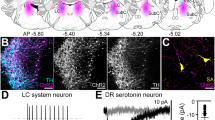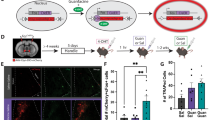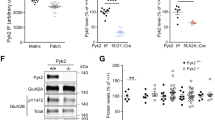Abstract
α1 Adrenergic receptors mediate a variety of physiological responses and have been well studied in the cardiovascular and peripheral nervous system. However, their role in the central nervous system remains ill defined because of the lack of highly specific ligands to the α1 receptor subtypes. Here, we have employed gene targeting to elucidate the role of α1d receptors in vivo. In addition to disrupting function, the insertion of the lacZ gene into the α1d receptor locus enabled the specific identification of cells expressing the α1d gene. These cells are localized in the cortex, hippocampus, olfactory bulb, dorsal geniculate and ventral posterolateral nuclei of the thalamus. Behaviorally, the α1d−/− mice show normal locomotor activity during the subjective day, or resting phase of their cycle. However, during subjective night, or active phase, wheel-running activity is significantly reduced in mutant mice. Furthermore, these mice show a reduction in exploratory rearing behavior in a novel cage environment. Lastly, α1d−/− mice show reduced hyperlocomotion after acute amphetamine administration. Together, these data reveal the functional importance of α1d adrenoceptors in mediating a variety of stimulus-induced changes in locomotor behaviors. While the sensitivity of noradrenergic neurons to environmental stimuli has been well documented, our data demonstrate that at least some of these post-synaptic responses are mediated by α1d adrenergic receptors.
This is a preview of subscription content, access via your institution
Access options
Subscribe to this journal
Receive 12 print issues and online access
$259.00 per year
only $21.58 per issue
Buy this article
- Purchase on Springer Link
- Instant access to full article PDF
Prices may be subject to local taxes which are calculated during checkout






Similar content being viewed by others
References
Clark CR, Geffen GM, Geffen LB . Catecholamines and attention. I: Animal and clinical studies. Neurosci Biobehav Rev 1987; 11: 341–352.
De Sarro GB, Ascioti C, Froio F, Libri V, Nistico G . Evidence that locus coeruleus is the site where clonidine and drugs acting at alpha 1- and alpha 2-adrenoceptors affect sleep and arousal mechanisms. Br J Pharmacol 1987; 90: 675–685.
Harley C . Noradrenergic and locus coeruleus modulation of the perforant path- evoked potential in rat dentate gyrus supports a role for the locus coeruleus in attentional and memorial processes. Prog Brain Res 1991; 88: 307–321.
Puumala T, Riekkinen P, Sr Sirvio J . Modulation of vigilance and behavioral activation by alpha-1 adrenoceptors in the rat. Pharmacol Biochem Behav 1997; 56: 705–712.
Stone EA, Zhang Y, Rosengarten H, Yeretsian J, Quartermain D . Brain alpha 1-adrenergic neurotransmission is necessary for behavioral activation to environmental change in mice. Neuroscience 1999; 94: 1245–1252.
Stone EA, Lin Y, Itteera A, Quartermain D . Pharmacological evidence for the role of central alpha 1B-adrenoceptors in the motor activity and spontaneous movement of mice. Neuropharmacology 2001; 40: 254–261.
Pichler L, Kobinger W . Possible function of alpha 1-adrenoceptors in the CNS in anaesthetized and conscious animals. Eur J Pharmacol 1985; 107: 305–311.
Knauber J, Muller WE . Subchronic treatment with prazosin improves passive avoidance learning in aged mice: possible relationships to alpha1-receptor up-regulation. J Neural Transm 2000; 107: 1413–1426.
Shi WX, Pun CL, Zhang XX, Jones MD, Bunney BS . Dual effects of D-amphetamine on dopamine neurons mediated by dopamine and nondopamine receptors. J Neurosci 2000; 20: 3504–3511.
Taghzouti K, Simon H, Herve D, Blanc G, Studler JM, Glowinsski J, LeMMoal M, Tassin JP . Behavioural deficits induced by an electrolytic lesion of the rat ventral mesencephalic tegmentum are corrected by a superimposed lesion of the dorsal noradrenergic system. Brain Res 1988; 440: 172–176.
Tassin JP, Simon H, Herve D, Blanc G, LeMMoal M, Glowinsski J, Bockkaert J . Non-dopaminergic fibres may regulate dopamine-sensitive adenylate cyclase in the prefrontal cortex and nucleus accumbens. Nature 1982; 295: 696–698.
Tassin JP, Studler JM, Herve D, Blanc G, Glowinski J . Contribution of noradrenergic neurons to the regulation of dopaminergic (D1) receptor denervation supersensitivity in rat prefrontal cortex. J Neurochem 1986; 46: 243–248.
Tessel RE, Barrett JE . Antagonism of the behavioral effects of cocaine and d-amphetamine by prazosin. Psychopharmacology 1986; 90: 436–440.
Trovero F, Blanc G, Herve D, Vezina P, Glowinski J, Tassin JP . Contribution of an alpha 1-adrenergic receptor subtype to the expression of the ‘ventral tegmental area syndrome’. Neuroscience 1992; 47: 69–76.
Trovero F, Marin P, Tassin JP, Premont J, Glowinski J . Accelerated resensitization of the D1 dopamine receptor-mediated response in cultured cortical and striatal neurons from the rat: respective role of alpha 1-adrenergic and N-methyl-D-aspartate receptors. J Neurosci 1994; 14: 6280–6288.
Snoddy AM, Tessel RE . Prazosin: effect on psychomotor-stimulant cues and locomotor activity in mice. Eur J Pharmacol 1985; 116: 221–228.
Darracq L, Blanc G, Glowinski J, Tassin JP . Importance of the noradrenaline–dopamine coupling in the locomotor activating effects of D-amphetamine. J Neurosci 1998; 18: 2729–2739.
Blanc G, Trovero F, Vezina P, Herve D, Godeheu AM, Glowinski J, Tassin JP . Blockade of prefronto-cortical alpha 1-adrenergic receptors prevents locomotor hyperactivity induced by subcortical D-amphetamine injection. Eur J Neurosci 1994; 6: 293–298.
Altman JD, Trendelenburg AU, MacMillan L, Bernstein D, Liimbird L, Kobilka BK, Hein L, . Abnormal regulation of the sympathetic nervous system in alpha2A-adrenergic receptor knockout mice. Mol Pharmacol 1999; 56: 154–161.
Chruscinski AJ, Rohrer DK, Schauble E, Desai KF, Bernstein D, Kobilka BBK . Targeted disruption of the beta2 adrenergic receptor gene. J Biol Chem 1999; 274: 16694–16700.
Cavalli A, Lattion AL, Hummter E, Nenninger M, Pedrazzinii T, Auberrt JK, Michel MC, Yang M, Lembo G, Vecchione C, Mostardini M, Schmidt A, Beermann F, Cotecchia S . Decreased blood pressure response in mice deficient of the alpha1b- adrenergic receptor. Proc Natl Acad Sci USA 1997; 94: 11589–11594.
Rokosh DG, Simpson PC . Knockout of the α1A/C-adrenergic receptor subtype: the α1A/C is expressed in resistance arteries and is required to maintain arterial blood pressure. Proc Natl Acad Sci USA 2002; 99: 9474–9479.
Rohrer DK, Desai KH, Jasper JR, Stevens ME, Regula DP Jr, Barsh GSS, Bernstein D, Kobilka BK . Targeted disruption of the mouse beta1-adrenergic receptor gene: developmental and cardiovascular effects. Proc Natl Acad Sci USA 1996; 93: 7375–7380.
Link RE, Desai KH, Hein L, Stevens ME, Chruscinski A, BBernstein D, Barsh GS, Kobilka BK . Cardiovascular regulation in mice lacking alpha2-adrenergic receptor subtypes b and c. Science 1996; 273: 803–805.
Susulic VS et al. Targeted disruption of the beta 3-adrenergic receptor gene. J Biol Chem 1995; 270: 29483–29492.
Hess HJ . Prazosin: biochemistry and structure-activity studies. Postgrad Med 1975; Special issue: 9–17.
Stone EA, Rosengarten H, Lin Y, Quartermain D . Pharmacological blockade of brain alpha1-adrenoceptors as measured by ex vivo [3H]prazosin binding is correlated with behavioral immobility. Eur J Pharmacol 2001; 420: 97–102.
Kaestner KH, Montoliu L, Kern H, Thulke M, Schutz G . Universal beta-galactosidase cloning vectors for promoter analysis and gene targeting. Gene 1994; 148: 67–70.
Chomczynski P, Sacchi N . Single-step method of RNA isolation by acid guanidinium thiocyanate–phenol–chloroform extraction. Anal Biochemistry 1987; 162: 156–159.
Kaestner KH, Ntambi JM, Kelly Jr TJ, Lane MD . Differentiation-induced gene expression in 3T3-L1 preadipocytes. A second differentially expressed gene encoding stearoyl-CoA desaturase. J Biol Chem 1989; 264: 14755–14761.
Tamura T, Sumita L, Fujino I, Aoyama A, Horikoshi M, Hofffmann A, Roeder RG, Muramatsu M, Mikoshiba K . Striking homology of the ‘variable’ N-terminal as well as the ‘conserved core’ domains of the mouse and human TATA-factors (TFIID). Nucleic Acids Res 1991; 19: 3861–3865.
Nolan PM, Houpt TA, Bucan M . Chemical mutagenesis and screening for mouse mutations with an altered rest-activity pattern. in Lydic, R (ed). Molecular Regulation of Aroual States. CCR Press LLC: Boca Raton, 1998, pp 143–156.
Paxinos G, Franklin K . The Rat Brain In Stereotaxic Coordinates. Academic Press, San Diego, 1996.
Aston-Jones G, Chen S, Zhu Y, Oshinsky ML . A neural circuit for circadian regulation of arousal. Nat Neurosci 2001; 4: 732–738.
Aston-Jones G, Bloom FE . Activity of norepinephrine-containing locus coeruleus neurons in behaving rats anticipates fluctuations in the sleep–waking cycle. J Neurosci 1981; 1: 876–886.
Hobson JA, McCarley RW, Wyzinski PW . Sleep cycle oscillation: reciprocal discharge by two brainstem neuronal groups. Science 1975; 189: 55–58.
Geyer MA, Segal DS, Mandell AJ . Effect of intraventricular infusion of dopamine and norepinephrine on motor activity. Physiol Behav 1972; 8: 653–658.
Heal DJ . Phenylephrine-induced activity in mice as a model of central alpha 1- adrenoceptor function. Effects of acute and repeated administration of antidepressant drugs and electroconvulsive shock. Neuropharmacology 1984; 23: 1241–1251.
Dickinson SL, Gadie B, Tulloch IF . Alpha 1- and alpha 2-adrenoreceptor antagonists differentially influence locomotor and stereotyped behaviour induced by D-amphetamine and apomorphine in the rat. Psychopharmacology 1988; 96: 521–527.
Anden NE, Strombom U . Adrenergic receptor blocking agents: effects on central noradrenaline and dopamine receptors and on motor activity. Psychopharmacologia 1974; 38: 91–103.
Day HE, Campeau S, Watson Jr SJ, Akil H . Distribution of alpha 1a-, alpha 1b- and alpha 1d-adrenergic receptor mRNA in the rat brain and spinal cord. J Chem Neuroanat 1997; 13: 115–139.
Rokosh DG et al. Distribution of alpha 1C-adrenergic receptor mRNA in adult rat tissues by RNase protection assay and comparison with alpha 1B and alpha 1D. Biochem Biophys Res Commun 1994; 200: 1177–1184.
Sirvio J, MacDonald E . Central alpha1-adrenoceptors: their role in the modulation of attention and memory formation. Pharmacol Ther 1999; 83: 49–65.
Kostowski W . Possible relationship of the locus coeruleus-hippocampal noradrenergic neurons to depression and mode of action of antidepressant drugs. Pol J Pharnac 1985; 37: 727–743.
McCormick DA . Cholinergic and noradrenergic modulation of thalamocortical processing. Trends Neurosci 1989; 12: 215–221.
Jones LS, Gauger LL, Davis JN . Anatomy of brain alpha 1-adrenergic receptors: in vitro autoradiography with [125I]-heat. J Comp Neurol 1985; 231: 190–208.
Oddie SD, Stefanek W, Kirk IJ, Bland BH . Intraseptal procaine abolishes hypothalamic stimulation-induced wheel-running and hippocampal theta field activity in rats. J Neurosci 1996; 16: 1948–1956.
Nolan PM, Kapfhamer D, Bucan M . Random mutagenesis screen for dominant behavioral mutations in mice. Methods 1997; 13: 379–395.
Sara SJ, Dyon-Laurent C, Herve A . Novelty seeking behavior in the rat is dependent upon the integrity of the noradrenergic system. Brain Res Cogn Brain Res 1995; 2: 181–187.
Spreng M, Cotecchia S, Schenk F . A behavioral study of alpha-1b adrenergic receptor knockout mice: increased reaction to novelty and selectively reduced learning capacities. Neurobiol Learn Mem 2001; 75: 214–229.
Pifl C, Drobny H, Reither H, Hornykiewicz O, Singer EA . Mechanism of the dopamine-releasing actions of amphetamine and cocaine: plasmalemmal dopamine transporter versus vesicular monoamine transporter. Mol Pharmacol 1995; 47: 368–373.
Florin SM, Kuczenski R, Segal DS . Regional extracellular norepinephrine responses to amphetamine and cocaine and effects of clonidine pretreatment. Brain Res 1994; 654: 53–62.
Kuczenski R, Segal DS . Locomotor effects of acute and repeated threshold doses of amphetamine and methylphenidate: relative roles of dopamine and norepinephrine. J Pharmacol Exp Ther 2001; 296: 876–883.
Lindvall O, Bjorklund A, Skagerberg G . Selective histochemical demonstration of dopamine terminal systems in rat di- and telencephalon: new evidence for dopaminergic innervation of hypothalamic neurosecretory nuclei. Brain Res 1984; 306: 19–30.
Drouin C et al. Alpha1b-adrenergic receptors control locomotor and rewarding effects of psychostimulants and opiates. J Neurosci 2002; 22: 2873–2884.
Acknowledgements
We thank Dr Maja Bucan for helpful discussions and analysis of wheel-running activity, Sreekanth Chalasani for help with graphics and Misty Godfrey for excellent animal husbandry.
Author information
Authors and Affiliations
Corresponding author
Rights and permissions
About this article
Cite this article
Sadalge, A., Coughlin, L., Fu, H. et al. α1d Adrenoceptor signaling is required for stimulus induced locomotor activity. Mol Psychiatry 8, 664–672 (2003). https://doi.org/10.1038/sj.mp.4001351
Received:
Revised:
Accepted:
Published:
Issue Date:
DOI: https://doi.org/10.1038/sj.mp.4001351
Keywords
This article is cited by
-
Norepinephrine regulates calcium signals and fate of oligodendrocyte precursor cells in the mouse cerebral cortex
Nature Communications (2023)
-
Autoantibodies targeting GPCRs and RAS-related molecules associate with COVID-19 severity
Nature Communications (2022)
-
Is Tamsulosin Linked to Dementia in the Elderly?
Current Urology Reports (2018)
-
Differential gene expression in the body wall of the sea cucumber (Apostichopus japonicus) under strong lighting and dark conditions
Acta Oceanologica Sinica (2018)
-
Ten commercial antibodies for alpha-1-adrenergic receptor subtypes are nonspecific
Naunyn-Schmiedeberg's Archives of Pharmacology (2009)



